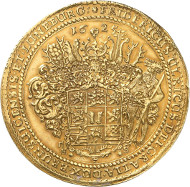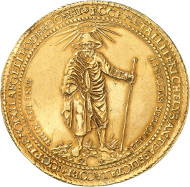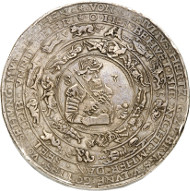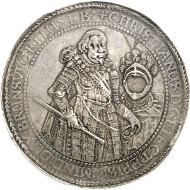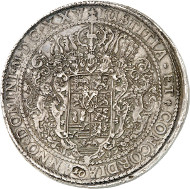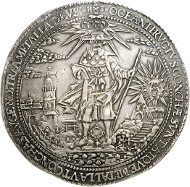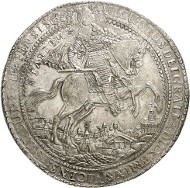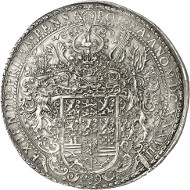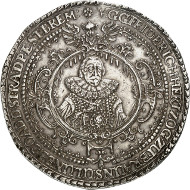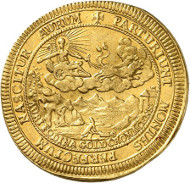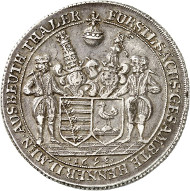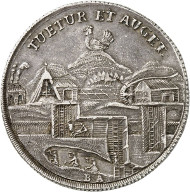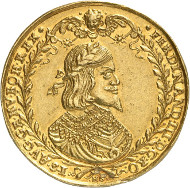29-10-2015 – 01-01-1970
Auction 1: Löser and mining coins from Preussag
Fantastic coins achieve fantastic results
Lot 43: BRUNSWICK-WOLFENBÜTTEL. Frederick Ulrich, 1613-1634. Gold löser of 17 gold gulden 1625, Goslar or Zellerfeld. Made of metal mined from the St. Jakob Mine at Lautenthal. Specimen from the Pogge and Vogelsang Collection. Unique. Extremely fine. Estimate: 150,000,- GBP. Hammer price: 650,000,- GBP.
An impressive 650,000 pounds was the final bid for a jakobslöser in gold in the weight of 20 goldgulden sold at the auction conducted by London Coin Galleries in collaboration with Künker, on October 30, 2015. Jakobslöser were issued as a testimony to the quick pace at which the ducal mining authority had successfully made the “Großer St. Jakob” Mine at Lautental economically lucrative. Constituting part of the Preussag Collection, not only löser of 4, 3, and 2 reichsthaler were offered for sale, but also a gold pattern that once belonged to the private collection of the Mecklenburg-based merchant Carl Friedrich Pogge (1752-1840). At his time, Pogge ranged among the most famous coin collectors in young Germany. He was one of the most generous benefactors of the newly-founded provincial museum of New Western Pomerania and Rugia. Parts of his collection were given to this institution and the Rugian-Pomeranian Historical Society. In 1903, his descendants first sold this gold pattern of a löser of the “Großer St. Jakob” Mine through L. & L. Hamburger in Frankfurt. Since then, this pattern was part of several important collections, such as the Vogelsang Collection. The proud new owner of this precious item acquired the piece for a price equivalent to 911,500 euros or 1 million US dollars.
Anyone who did not wish to spend as much money on a new acquisition was given the opportunity to purchase an item from the same emission, but in a lighter weight and not made of gold. This löser of 2 reichsthaler, graded very fine with only small scratches and a rim nick, went over the auction block for 2,600 pounds.
Lot 8: BRUNSWICK-WOLFENBÜTTEL. Julius, 1568-1589. Löser of 10 reichsthaler 1583, Heinrichstadt (Wolfenbüttel), with struck cipher of value. Extremely rare. Very fine. Estimate: 20,000,- GBP. Hammer price: 46,000,- GBP.
With that said, it certainly becomes apparent how the pricing in regards to the löser worked: the collector who intended to acquire a magnificently preserved item in the weight of several reichsthaler had to pay a price in the six-digit range. Those who settled for a denomination not quite as heavy arrived in the lower to middle four-digit range. Here are a few examples:
- Julius of Brunswick-Wolfenbüttel. Löser of 10 reichsthaler 1583, Heinrichstadt. Very fine. Estimate: 20,000 pounds. Hammer price: 46,000 pounds. – Struck two years later, the löser of 3 reichsthaler reached a hammer price of 6,000 pounds.
- Rudolf August of Brunswick-Wolfenbüttel. Löser of 7 reichsthaler 1686, Zellerfeld. Very fine. Estimate: 25,000 pounds. Hammer price: 75,000 pounds. – The price of the same löser type of 2 reichsthaler ranged between 2,200 and 2,800 pounds.
Lot 115: BRUNSWICK-LÜNEBURG-CELLE. Christian, Bishop of Minden, 1611-1633. Löser of 10 reichsthaler 1625, Clausthal(?). Extremely rare. Extremely fine. Estimate: 50,000,- GBP. Hammer price: 160,000,- GBP.
- Christian, Bishop of Minden. Löser of 10 reichsthaler 1625. Extremely fine. Estimate: 50,000 pounds. Hammer price: 160,000 pounds. – A specimen of the series of 4 reichsthaler obtained a hammer price of 7,000 pounds, another of 3 reichsthaler, from 1629, 5,500 pounds.
Lot 47: BRUNSWICK-WOLFENBÜTTEL. Frederick Ulrich, 1613-1634. Löser of 10 reichsthaler 1634, Zellerfeld. Made of metal mined from the St. Jakob Mine at Lautenthal. Very rare. Extremely fine. Estimate: 40,000,- GBP. Hammer price: 160,000,- GBP.
Of course, the great rarities featuring interesting depictions were particularly popular. For example a slightly later löser of 10 reichsthaler, dating from 1634, on the afore-mentioned “Großer St. Jakob” Mine. The Preussag Collection offered three different variants of this coin: a löser of 10 reichsthaler obtained 160,000 pounds (estimate: 40,000), a löser of 6 reichsthaler 60,000 pounds (estimate: 15,000), and a second die variant of the löser of 10 reichsthaler was sold for 150,000 pounds (estimate: 30,000).
Lot 73: BRUNSWICK-WOLFENBÜTTEL. August the Younger, 1635-1666. Löser of 10 reichsthaler 1638, Zellerfeld. Very rare. Extremely fine. Estimate: 40,000,- GBP. Hammer price: 220,000.- GBP.
To conclude this overview of löser, have a look at the following list of coins which yielded prices ranging in the six-digit region:
- August the Younger of Brunswick-Wolfenbüttel. Löser of 10 reichsthaler 1638, Zellerfeld. Extremely fine. Estimate: 40,000 pounds. Hammer price: 220,000 pounds.
- Ferdinand Albrecht I of Brunswick-Bevern. Löser of 4 reichthaler 1670, Clausthal. Extremely fine. Estimate: 25,000 pounds. Hammer price: 170,000 pounds.
Lot 130: BRUNSWICK-LÜNEBURG-CELLE. Frederick, 1636-1648. Löser of 10 reichsthaler 1639, Clausthal. Unique. Extremely fine. Estimate: 60,000,- GBP. Hammer price: 130,000,- GBP.
- Frederick of Brunswick-Lüneburg-Celle. Löser of 10 reichsthaler 1639, Clausthal. Extremely fine. Estimate: 60,000 pounds. Hammer price: 130,000 pounds.
Not as expensive but just as interesting were the 327 mining coins offered for sale at the auction. They bear testimony to the pride of the territorial princes possessing and operating mines with state-of-the-art equipment. To really appreciate the depictions on these coins, just imagine the Federal Republic of Germany – taking the same pride in its economy – striking commemorative coins featureing machinery necessary to produce a Mercedes Benz or an internationally renown product such as the Fischer plug.
Lot 226: BRANDENBURG-FRANCONIA. Christian Ernest, 1655-1712. 2 ducats 1695, Bayreuth. Made of metal mined from the mines at Goldkronach. Extremely rare. Extremely fine. Estimate: 20,000,- GBP. Hammer price: 50,000,- GBP.
While rarities like the 1695 double ducat of Christian Ernest of Brandenburg-Bayreuth, made of metal mined from the Goldkronach mines and graded extremely fine, obtained 50,000 pounds (estimate: 20,000 pounds) and the Russian 1832 5 rouble piece, minted in St. Petersburg and made of metal mined from the Kolyvan gold mines, achieved 55,000 Pounds (estimate: 20,000 Pounds), the final bids for a number of highly attractive specimens, in contrast, ranged in the lower four-digit region. A striking example is a magnificent silver medal of Ernest August of Brunswick-Calenberg-Hanover with a detailed depiction of a horse capstan. Estimated at 600 pounds, this very rare medal changed hands for 1,800 pounds.
Lot 349: HENNEBERG. Reichsthaler 1698, Ilmenau. Made of metal mined from the mines at Ilmenau. Nearly extremely fine. Estimate: 600,- GBP. Hammer price: 900,- GBP.
By acquiring a 1698 reichsthaler from the Henneburg County, minted in Ilmenau, the buyer received even more mining depictions for less money. This coins’ reverse provides a detailed look into the daily routine of the miners working in the shafts and tunnels. It was estimated at 600 pounds but changed hands for 900 pounds at the sale.
Lot 485: HRE. Ferdinand III, 1625-1637-1657. 10 ducats 1648. Made of metal mined from the Ferdinand Mine at Schemnitz. Probably unique. Extremely fine. Estimate: 100,000,- GBP. Hammer price: 260,000,- GBP.





